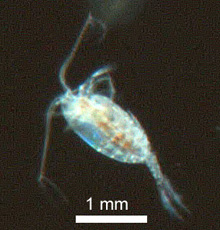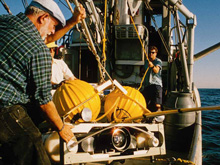A RopeCam (shown here on an earlier mission) is ready to be launched over the side of the ship. The two yellow balls on the top of the frame will provide buoyancy and ensure that the camera remains right-side up while it hangs suspended at depth. Click image for larger view and image credit.
The Show Must Go On!
October 7, 2007
Caron De Mars
Environment, Science, and Technology Officer
U.S. Embassy, Manila
One sampling tool on board that several of us have mentioned is the RopeCam. This high-resolution camera is aimed at weighted bait that is lowered to the ocean floor with nearly two miles of spliced rope. This morning National Geographic photographer Emory Kristof baited the hook with a handsome yard-long king mackerel and the crane lifted Emory’s savory fish-luring contraption over the side of the BRP Hydrographer Presbitero.
Five hours later the recovery team began pulling it back to the surface. Unbelievably, the polypropylene rope, rated at 3,000-pounds of strength, snapped during retrieval, releasing the RopeCam to a watery grave. Aghast witnesses immediately chased down Emory to break the news that his camera, worth about $25,000, had been sacrificed to the Celebes Sea.
Emory is a bigger-than-life world explorer who has pretty much seen and done it all since his 1962 initiation with National Geographic magazine. As a co-leader and cheerleader of this expedition, he rushed out, looked over the side rail at the broken rope floating on the quiet water, and broadcast in his booming voice, “Bring on the next act!”
… and indeed, Emory did bring it on. The remotely operated vehicle (ROV) was lowered into the water in less than two hours after the loss of the RopeCam and had a bonanza that evening: all but one of the samplers was full when it came up 5 hours and 15 minutes later! One “catch of the day” was a big Atolla, a bright red deep-sea jellyfish, 6 inches across, that looks like a flying saucer trailing multiple jet-streams. Another interesting creature captured was a siphonophore, a colonial jelly with a gillnet trailing its tail. An effective "curtain of death" the gillnet nabs any passing plankton to nourish the siphonophore.
In the wee hours of the morning, photographers, scientists, and cinematographers were crammed into the 12- by 21-foot lab, recording, preserving, and observing for hours on end. Some stayed in the lab until 4:30 am on the 8th. Miraculously, the mess hall was abuzz with customers at 6 am — a testimonial to exciting work and a craving for caffeine.
The vessel has become a 24/7 activity hub of preparation, execution, retrieval, and analysis. Each participant knows his or her niche, but is perfectly willing to branch out during slack times to lend a helping hand. Knot-master Ralph White splices and tends the RopeCam ropes, but he took time to whip up a beautiful knot for the whistle on my scuba buoyancy control device. Noe Gapas nets plankton for the Philippine National Museum, but is happy to assist the “jar fairies,” the people assigned to clean out the collection jars and fill them with seawater for the next bluewater dive. The vessel is fraught with examples of the teamwork necessary to make the project a success.




























